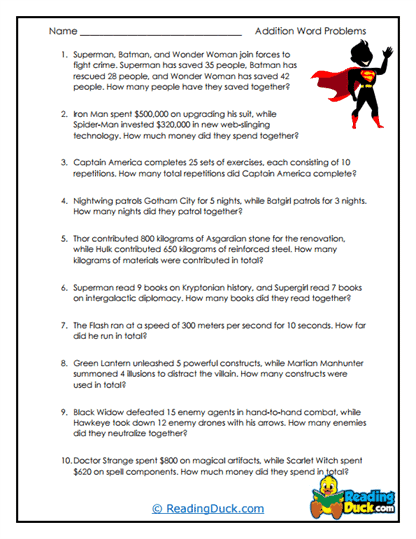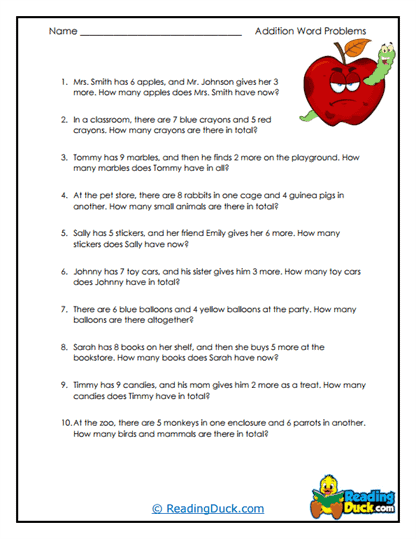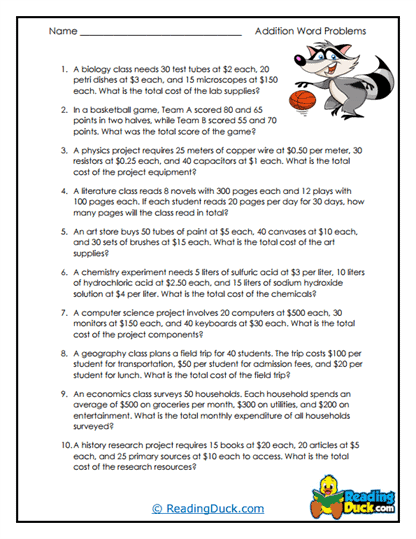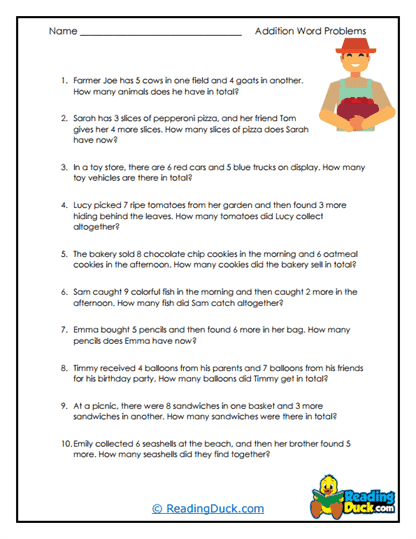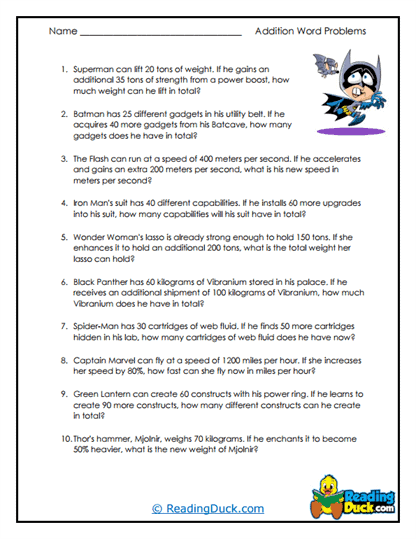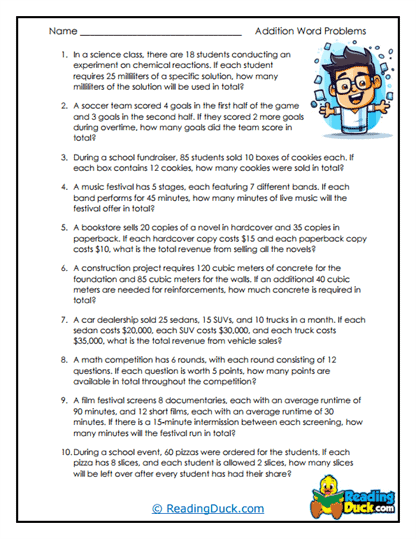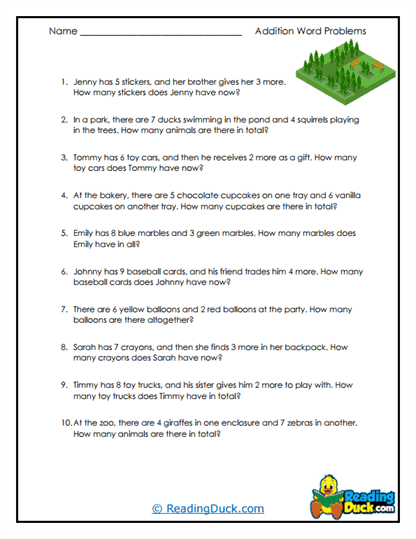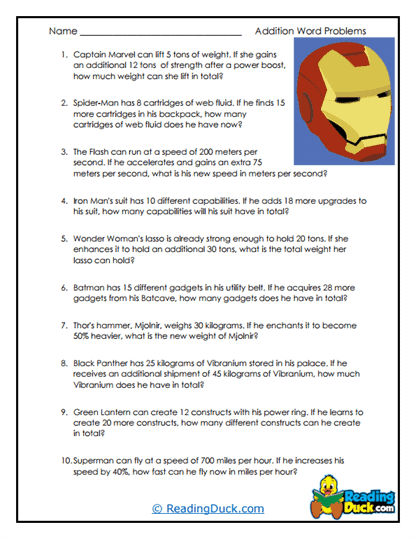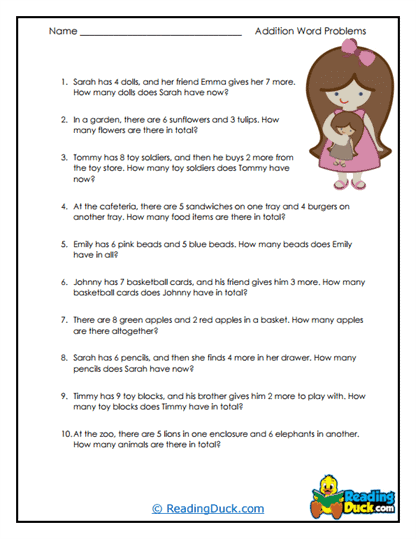Addition Word Problems Worksheets
About Our Addition Word Problem Worksheets
Our collection of Addition Word Problems worksheets provides an engaging and practical approach to help students develop their addition skills within real-world contexts. These worksheets are part of the Math: Word Problems category and are designed to reinforce the understanding of basic addition while also enhancing reading comprehension and critical thinking. Each worksheet set features a reading passage paired with a visually engaging, relevant picture to make the problems more relatable and interesting for students.
Each worksheet set includes:
- Multiple Choice Questions: These questions allow students to practice problem-solving by selecting the correct answer from multiple options, reinforcing their understanding of addition concepts in different contexts.
- Short Answer Questions: In this section, students are required to write out their answers, encouraging them to explain their thought process and solidify their understanding of how to approach addition word problems.
- Open-Ended Questions: These questions prompt students to offer personal input, opinions, or preferences related to the scenarios in the word problems. This format allows students to connect mathematical concepts to their own experiences, making the learning process more relatable and engaging.
An answer key is provided for every question sheet, making it easy for teachers and parents to review and assess students' work. All worksheets are available as PDF files, which can be easily viewed electronically, downloaded, and printed out for use in classrooms or homeschool settings.
Understanding Addition Word Problems: Building a Strong Foundation
Addition word problems are essential in early math education because they present addition in a practical context that students encounter in everyday life. These problems help bridge the gap between abstract mathematical operations and real-world applications, making math more tangible and accessible to young learners.
When teaching addition word problems, it's important to present the concept in a structured and engaging way. Here’s how you might introduce this topic to your students:
What Are Addition Word Problems?
Addition word problems are mathematical exercises presented in the form of a story or scenario. These problems require students to identify the relevant numerical information within the context of the narrative and then perform an addition operation to find the solution. The problems often depict real-life situations, such as combining quantities, calculating totals, or determining the sum of items in different groups.
Why Are Addition Word Problems Important?
- Real-World Application: Addition word problems show students how math is used in everyday life. Whether adding up grocery items, counting money, or determining the number of people in a group, these problems help students understand the practical utility of addition. This real-world connection makes math more relevant and engaging for students.
- Developing Critical Thinking: Word problems require more than just basic calculation; they demand that students read carefully, comprehend the scenario, and determine how to approach the problem. This process develops critical thinking and problem-solving skills, which are essential in both academic and real-life contexts.
- Enhancing Reading Comprehension: Since word problems are presented in a textual format, they naturally integrate reading comprehension with math. Students must understand the narrative, extract pertinent information, and translate it into a mathematical equation. This dual focus on literacy and numeracy strengthens students' overall academic abilities.
Key Components of Addition Word Problems
- Identifying the Numbers: The first step in solving an addition word problem is to locate the numbers that need to be added. These numbers are typically embedded in the story, requiring students to pay close attention to details. For example, if a problem describes three apples in one basket and five in another, students must recognize that these two numbers need to be added together.
- Understanding the Context: Students must grasp the context of the problem to know how the numbers relate to each other. Understanding whether the numbers represent quantities of the same item, amounts of money, or groups of people is crucial for deciding how to solve the problem. This step reinforces the importance of context in mathematical reasoning.
- Performing the Addition: After identifying the numbers and understanding the context, students then perform the addition operation to arrive at the solution. This step not only reinforces their basic math skills but also encourages accuracy and precision in calculation.
- Interpreting the Result: Once the addition is performed, students should interpret the result within the context of the problem. This means understanding what the sum represents—whether it’s the total number of items, the combined length of objects, or the total cost of several items. This final step ensures that students see the practical outcome of their mathematical work.
Common Scenarios in Addition Word Problems
- Combining Quantities: These problems involve combining two or more groups of the same item. For instance, a problem might ask students to find the total number of books if one student has 4 books and another has 3.
- Calculating Totals: Problems that involve calculating the total of several items are common. For example, a problem might describe a shopping trip where a student buys 3 apples, 2 bananas, and 5 oranges, asking for the total number of fruits purchased.
- Adding Money: Addition problems can also involve money, helping students practice financial literacy skills. A typical problem might involve adding up the cost of several items to find the total amount spent.
Creative Ways to Use Addition Word Problems Worksheets
Teachers and parents can use these Addition Word Problems worksheets in a variety of creative and effective ways to enhance students' learning experiences. Here are some ideas on how to incorporate these worksheets into your educational curriculum:
1. Integrating Math with Other Subjects
- Cross-Curricular Connections: Use the word problems to connect math with other subjects such as science, social studies, or language arts. For example, you can create word problems that involve counting objects in a science experiment, like how many plants grew in different pots, or adding up historical figures in a social studies timeline. This approach not only reinforces addition skills but also shows students how math is interconnected with other areas of knowledge.
- Storytelling and Math: After students read a story in language arts or a historical event in social studies, have them create their own addition word problems based on the narrative. This can include scenarios such as adding the number of soldiers in different armies or combining the number of animals mentioned in a fable. This activity reinforces math skills while encouraging creativity and deeper comprehension of the reading material.
2. Group Activities and Collaborative Learning
- Pair Work: Pair students together to solve the word problems. One student can read the problem aloud while the other writes down the solution, then they can switch roles. This collaborative approach encourages communication, teamwork, and allows students to learn from each other's strategies and thinking processes.
- Math Centers: Set up a math center in your classroom where students can work on the addition word problems independently or in small groups. Provide manipulatives like counters, blocks, or number lines to help them visualize the problems. This hands-on approach is particularly beneficial for visual and kinesthetic learners who need to see and touch to understand.
3. Real-Life Applications and Field Trips
- Classroom Store: Create a classroom store where students use play money to "purchase" items by solving addition word problems. For instance, students could add up the prices of different items to determine how much they need to "spend" and how much "change" they should receive. This activity not only reinforces addition skills but also introduces basic financial literacy concepts in a fun, interactive way.
- Field Trip Math: If your class goes on a field trip, incorporate addition word problems related to the trip. For example, if you visit a zoo, you could create problems about the total number of animals in different exhibits or the combined number of miles walked during the visit. This makes math learning more dynamic and tied to real-world experiences, helping students see the relevance of math outside the classroom.
4. Personalized Learning and Differentiation
- Tailored Problems: Customize the word problems to match the individual needs and abilities of your students. For struggling learners, simplify the problems by using smaller numbers or more straightforward scenarios. For advanced learners, increase the complexity by adding more steps, using larger numbers, or introducing multi-step problems. Differentiating the worksheets ensures that all students are appropriately challenged and engaged at their level.
- Student-Created Problems: Encourage students to write their own word problems based on their interests and experiences. They can then exchange problems with classmates to solve. This not only makes learning more personalized and relevant but also helps students take ownership of their math practice. It’s a great way to deepen their understanding by seeing how math applies to their own lives.
By using these Addition Word Problems worksheets creatively, teachers and parents can help students develop a solid foundation in addition while also enhancing their problem-solving abilities, reading comprehension, and critical thinking skills. These worksheets are not just about practicing math; they are about making math a meaningful and engaging part of students' everyday lives. Through real-world scenarios and interactive learning approaches, students can see the practical applications of their mathematical knowledge, building confidence and enthusiasm for math.
